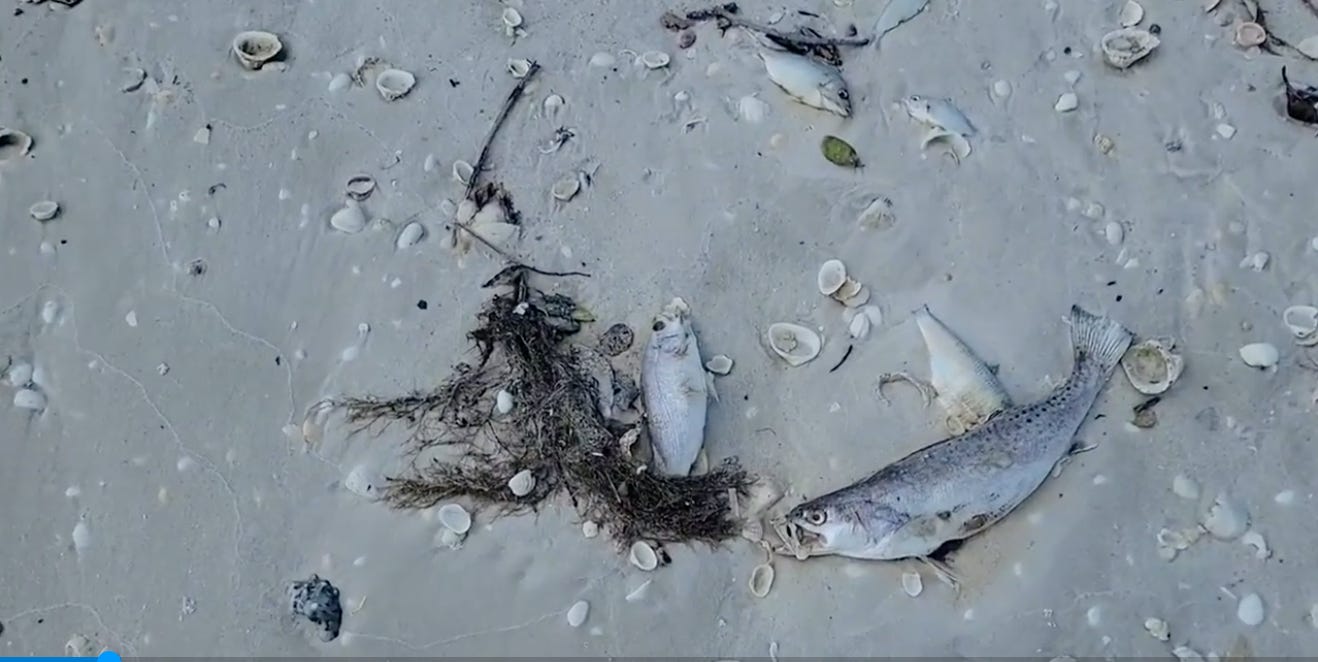
March 2023
[Note: Photos and underlined text contain links to other websites for reference.]
Anna Maria Island, FL — Call me someone in search of relief from Vermont’s cold, snowy, mud season in March. Call me hoodwinked. Call me blind-sided. Call me foolish. Call me gullible or even deceived. But don’t call me oblivious, because I know what I see, smell, inhale, and taste here on Anna Maria Island (AMI) off Florida’s central western coast — and it stinks.
Airborne red tide brevetoxins, a toxic bacteria aerosolized and “gassified” by wind and surf along Florida beaches, pose a serious threat to people, fish, and birds as they inhale neurotoxins from growing algae blooms. This may well be today’s greatest gas chamber as unsuspecting tourists and residents alike are doused by invisible airborne toxins that may cause long-term neurological damage. A massive gas chamber, of sorts, disguised by natural beauty.
People say AMI has that “old Florida” feel to it, with its low-slung bungalows of vibrant red, yellow, green, and turquoise-colored homes that leap off the street to awaken even the sleepiest of passers-by. Yet, old Florida wasn’t plagued by the red tide like it is today. When I visited Florida as a child, the only thing that afflicted me was sunburn. Now, as I venture outside, a constant tickle in my throat, a persistent cough, burning nostrils, and stinging, watery eyes are the order of the day — all while wondering about any longer-term lingering effects red tide may have on my central nervous system that may lead to early-onset neurodegenerative disease like ALS (Lou Gherig’s Disease), Alzheimer’s, or Parkinson’s.
After all, the red tide organism produces toxins that affect the central nervous systems of fish and other invertebrates, causing them to die. Another source suggests, “The organism produces a toxin that can affect the central nervous systems of fish, birds, mammals, and other animals.” Does this affect and afflict human brains? If so, how quickly and for how long? Are fish in this case a leading indicator of human wellness and illness? Are they a barometer we should be watching just as closely as sailors seek changes in barometric pressure as they embark on a long sea journey or ‘round-the-buoy races? While most sources about red tide prominently state it is a “naturally occurring” microscopic algae, don’t let this fool you. While it’s been around for hundreds of years, man-made pollutants have exacerbated red tide’s impact and reach, making it worse than before.
Today, I felt it might be safe to head to the beach, Holmes Beach, a mid-point on the western, or Gulf of Mexico, side of AMI. Picture it. Pristine white sand — “sugar sand” as the locals call it — sifting itself tantalizingly up through my toes so generously in the warm Gulf breeze blowing onshore. Palm trees. Brightly-colored beach umbrellas with lounge chairs waiting to be claimed. A good book in my bag waiting to be opened. The brilliant sun. Blue skies. Children running wide-eyed toward the beach exclaiming, “oh, look how beautiful!”, as their parents shuttle beach chairs and water toys in earnest excitement for the first day of a vacation by the shore. The occasional raucous tern, wheeling through the sky, its call a high screech heard far and wide. Joy pervades a seaside arrival after a hot walk from a rented bungalow. Expectant swimmers, towels in hand, bathing suits donned. A classic beach day? Unfortunately, not. The locals know a dirty little secret they don’t tend to share freely with those from “away”.
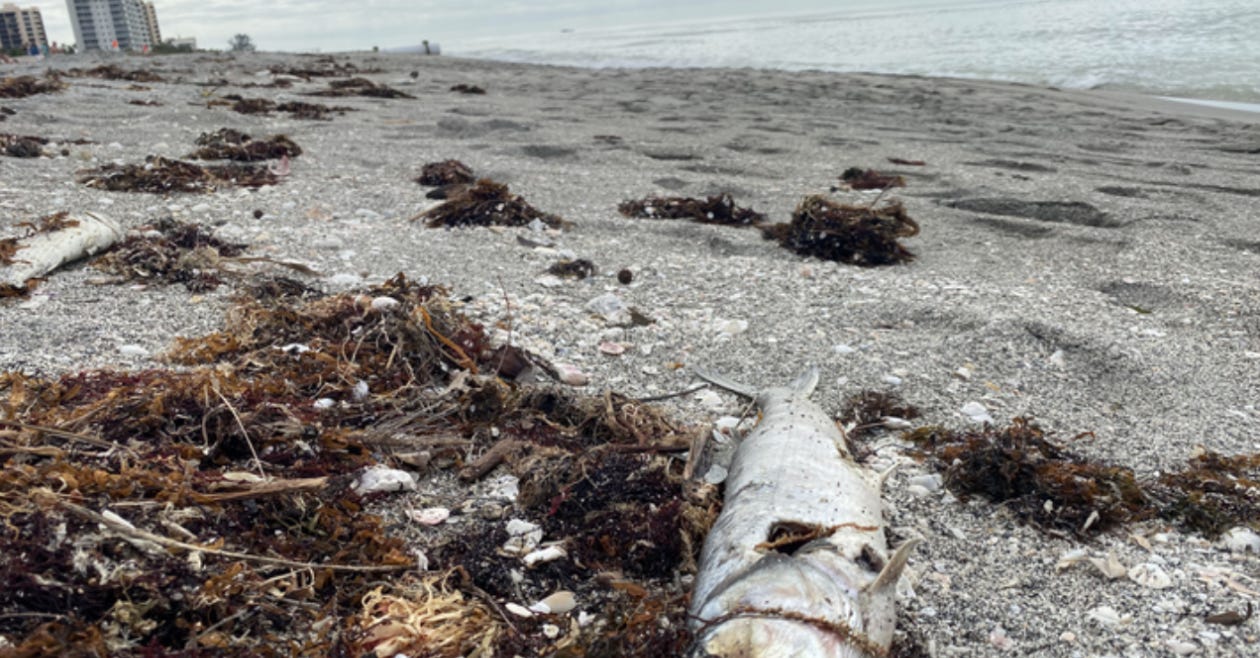
As my partner and I get settled onto lounge chairs, the smell of decaying fish overwhelms us. Closer to the high water mark, dead fish, bloated silver corpses, part-buried on their sides, peer up endlessly through unseeing, red-tide-defiled fish eyes clouded with terminal blindness. I call this oblivious lack of ‘seeing what is’, something called “Fish-Eye Syndrome”, my own moniker, coined here for the first time. It’s that inescapable perspective a beachgoer suddenly understands when they taste, smell, and feel the effects of the red tide all around Florida’s coastline. It’s an oddly-warped view of the beach — and the natural world — and its beauty that has evolved over time as reality in their mind’s eye. What people have become habituated to believe about Floridian beaches as pure and pristine is false and, worse, it’s dangerous to them and their children.
Fish-Eye Syndrome
1. The slow creep of change in our surroundings that fosters a warped view of the environment in which we live, obscuring reality and dangers present.
2. An alteration of belief structures in ways that may be harmful or damaging to current and future generations.
[Note: This is distinct from Fish Eye Disease which is a progressive physical eye disorder that causes the clear front surface of the eyes (the corneas) to gradually become cloudy.]
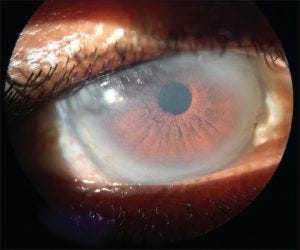
Suddenly, beachgoers realize they’ve been taken, fooled, tricked, duped, and defrauded by all the alluring web pages and photos that abound on every vacation enthusiast’s search for the perfect warm-weather getaway. Snowbirds beware. These beaches are not what they’ve been held out to be. West coast Florida beaches are advertised as some of the most beautiful beaches on earth, easy to reach for US tourists, across web sites and in magazines. They’ve become part of our national psyche as natural treasures to be enjoyed to their fullest. Red tide has made this a fallacy.
Suddenly, I realize, I, too, have been suckered by the marketing mavens who lured me to this dangerous place. Yet, I also know that with a bit of research, a mask, a camera, and a keyboard, I can help expose what’s been going on here for decades.
Thinking about a Florida beach vacation? Think again.
The red tide, a type of microscopic algae that’s harmful to aquatic, avian, and human life, a dinoflagellate known as Karenia brevis (K. brevis), ought to stop you in your tracks. Go someplace else for your next vacation because you’re likely to run into K. brevis pretty much anywhere on Florida’s southern coastline, east or west, including its offshore islands and keys. K. brevis is unpredictable where or when it will occur, but know that in my unrelenting quest to seek information about where the red tide is and isn’t on any given day, I’ve not been able to get an accurate picture. Without constant testing everywhere, all along all shoreline areas, it’s not possible to know when and where red tide is present.
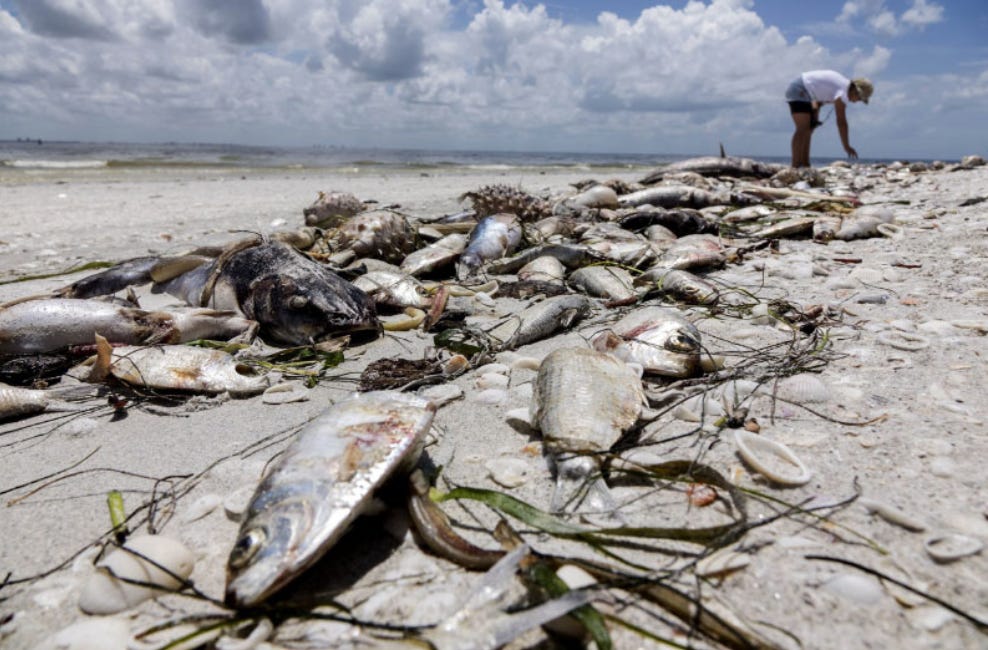
Today, up-to-date real estate agent and boat rental company web pages proudly state the red tide isn’t here and the water is safe for swimming, boating, fishing, and other water sports. Official state and county online maps tell me that red tide concentrations today are very low or not present. I checked other official-looking online maps and web sites before venturing to the beach, learning that the current wind conditions and virtually no red tide presence make for a good beach day. I went. I saw. I smelled and tasted the raw odor of dead fish on the onshore breeze. I saw fish carcasses floating on the waves — their bodies awash in the sand.
We left the beach after less than thirty minutes because of the dead fish stench and the burning in our nostrils. We were coughing and listening to everyone around us cough like a cacophony of kids in a primary care pediatric waiting room at the start of a new school year. Swimming with dead fish floating upside down in the surf was not our idea of a good time. But wait, there’s more…
…at Bridge Street, where the crowds grew thick, everyone had that same, quick cough. It struck me as a scene from a pre-apocalyptic science fiction film foretelling some impending disaster to the entire human race.
Last night, we ventured out to Bridge Street, a popular shopping and dining area near Bradenton Beach, closer to the southern end of the Island from our Holmes Beach bungalow. I’d noticed earlier that day how my eyes were itchy as I wandered around an art & craft show on the island. And how my nose felt a burning sensation, as if I’d inhaled a dash of pepper, with a deep tickle in my throat that made me alternately sneeze then cough. None of it was debilitating. I’d been able to play a set of early-morning tennis with my partner before breakfast. She, too, was similarly afflicted. Others on an adjacent court, I’d also noticed, had telltale coughs as they hit the ball back and forth. I’d payed little attention to this minor impairment, but at Bridge Street, where the crowds grew thick, everyone had that same, quick cough. It struck me as a scene from a pre-apocalyptic science fiction film foretelling some impending disaster to the entire human race.
I’d been advised that morning by a friend who lives on Longboat Key that the prevailing winds aerosolize the red tide as the surf crashes ashore. (I call this “gasified red tide”.) The air was so laden with the microscopic algae it had become too difficult for his wife to breathe. She’d been admitted to an urgent care facility for treatment. This was normal for these friends who built their retirement home here on a beach about a decade ago. They accepted this outcome as part of everyday life. A challenge to be overcome. Her sickness dashed our plans to connect for dinner, so my partner and I went to a paddle-boat comedy show. On our way, we saw dozens and dozens of dead fish floating motionless among the boats in the marina where the paddle-wheeler we sought was docked. Onboard, we were told by the ship’s mate that the red tide was killing fish regularly, and that a dead 300 or 400-pound grouper had to be towed out of the harbor earlier that day.
My friend had said that wearing a mask helped prevent the cough, so that’s what we did, yet we were among a tiny minority of mask wearers wandering the Bridge Street shops. At one point, a woman stopped me to ask why the masks? She was a local, coming out her front door. Her tone was defensive. I told her the mask helped with my cough. That seemed to satisfy her as a non-offensive response, but her tone suggested she harbored concerns about my mask-wearing as sending a negative message to others about the dangers of red tide on her island home. The economy here must be suffering.
My newly-created Fish-Eye Syndrome notion presents itself clearly now. I sense that people here are proud, hard-working, and love this little island with great affection. They want to believe the red tide is a naturally-occurring organism that only comes along once in a while. Even then, it doesn’t impact the entire island all the time. Yet, our Uber driver told us this particular red tide event has been ongoing since September of 2022. That’s been more than six months of watery eyes, burning nostrils, and tickling throats with coughs, sinus, and other respiratory problems that lead some to seek emergency care. But, it doesn’t impact everyone to the point of complete debilitation. And people here are optimists. It’s a beautiful trait, yet it may obscure their vision of the dangers of red tide to the point of fatalistic oblivion. This optimistic pride and belief that the red tide will go away, or their ‘it’s-not-so-bad-so-may-as-well-live-with-it-and-make-the-best-of-it’ mentality is the Fish-Eye Syndrome at play.
The fish eye lens on a camera distorts and changes the viewers perspective of a scene. It creates an extremely wide-angle warping effect that’s also known as barrel distortion. It delivers an imprecise depiction of reality. Fish-Eye Syndrome, therefore, coupled with the slow-moving creep of change, can make us feel as if the red tide is perfectly normal. Children smell dead fish thinking that’s what a beach should smell like. They don’t know any better. Vacationers (known as “snowbirds” at this time of the year) and residents alike begin to to believe that the tickle in their throats is part of life on an island in the wind, the salt air, the sunshine. It’s fine to ignore it as normal. (Most media sources refer to red tide as a “naturally occurring” algae, trying to mask its otherwise deleterious effect with the language of nature.) Some call Fish Eye Syndrome things like “creeping normality.” Others call is “landscape amnesia.” Our short-term perspective of a landscape changing so glacially slowly inoculates us against believing something has actually changed substantially or harmfully. Change, then, becomes imperceptible and normal as an acceptable reality to us.
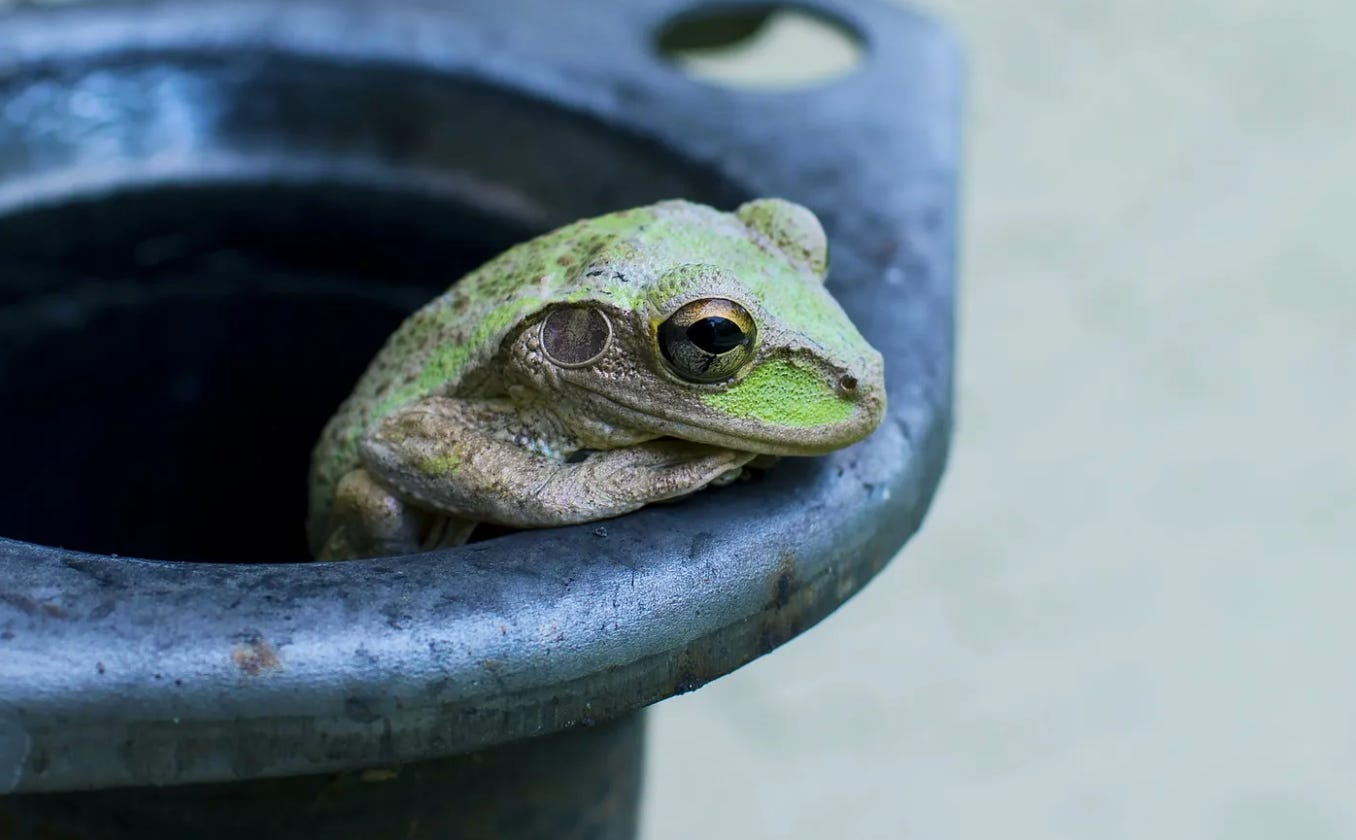
This is akin to the “Boiling Frog Syndrome” so many people have heard about. The belief that a frog in a pot on the stovetop won’t jump out as the heat is slowly increased has come under fire as myth. It is based on experiments done in the late 1800’s by a scientist named William Thompson Sedgwick, but has since been disproved. Yet, another scientific notion suggests that, like egg whites being dropped into boiling water, the proteins in a frog’s legs will coagulate and harden, thereby preventing it from jumping out of the pot even if it does feel the heat, even if it does know its death is looming.
It’s this latter notion that strikes me as most like what people here in Florida are experiencing. They might want to leave the red tide pot as it boils and bubbles around them, but they can’t because their distorted Fish Eye Syndrome view of their surroundings and their optimistic, make-the-best-of-it mentality, endearing as this may be, prevent them from fleeing a massive environmental disaster that has already engulfed them.
Florida’s governor, Ron DeSantis, has committed nearly $14 million in the State’s fiscal year 2023 budget to research red tide. Following the money trail of life, this tells me there’s far more at stake than a mere $14 million. Politicians’ moves often bely reality. In this case, businesses are suffering financial losses as word spreads and people either leave their homes for safer paces — Floridian red tide climate refugees — or the tourism industry suffers severely, or both! Even governor’s have to admit that Fish-Eye Syndrome will eventually be seen for what it is — the red tide that makes each fish eye floating upside down in a Floridian waterway or beached in white sand never to see again presents serious physical threats to all people and the aquatic and avian life we so cherish — and serious economic damage that can’t be ignored.
With so many people coughing and sneezing here on Anna Maria Island, nostrils feeling the burning sensation indicative of airborne neurotoxins (toxins produced by the red tide’s brevetoxin when aerosolized by surf and wind) making their way, insidiously, into our sinus membranes and deeper into our respiratory and nervous systems, it’s no wonder the marketing geniuses here in Florida want to hide and override the reality of what has become, to me, America’s greatest gas chamber.
Will there be a mass exodus? I think that’s unlikely. The beauty of the seascape and pristine white-sand beaches make for all-too-attractive images of a vacation paradise. Snowbirds will continue to flock here, lured by the many millions in advertising dollars spent to target and entice them. Retirees believe they’ve found their own slice of paradise after decades of arduous work in various industries. These are the optimists, the winners, the people who have worked hard and triumphed, and retired to their dream home utopias of Florida’s coastal beaches, golf courses, and sunshine. Will they give up their lifelong dreams? Unlikely.
Convincing people to change their lifelong perspectives of success and a life well-lived is an uphill battle. So, they live with what they have and where they are, content to feel happy even as they cough and sneeze. Even if they feel the heat being turned up beneath them, like the unsuspecting frog, they are incapable of overcoming their deep-seated beliefs of life here as indicative of success and beauty and paradise, making them incapable of jumping.
Like the fish floating and rotting, stinking in the onshore wind while breezes bloom inside nostrils young and old on Floridian beaches around the State, Fish Eye Syndrome’s distorting effect keeps working its magic slowly and imperceptibly. People will stay and continue to visit. Marketing magicians will continue to offer beautiful photos of sandy beaches and sunshine without all the dead fish depicted, plying their psychological-impact-trade so effectively. Society believes that this is paradise. Not much will change that belief short of a massive event that wakes people out of their reverie. I think that massive event is happening right now.
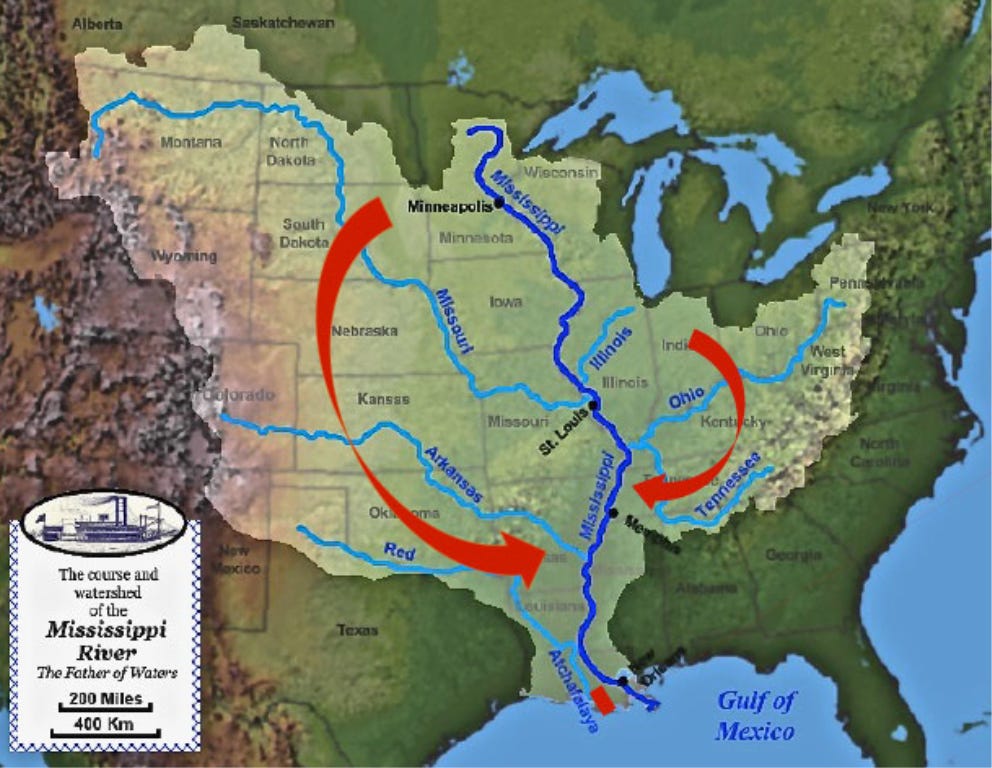
Industrial and agricultural outflows from federally-subsidized sugar cane growers, agricultural producers, golf courses, sewage treatment plants, and other urban runoff sources continue to overwhelm the lovely Gulf of Mexico with nitrogen-fed outflows until too many fish, all too often, wash up ashore and people can no longer tolerate their stench or eat fish for dinner. It will probably take a long-term mass extinction event (of fish, birds, or people) to finally and surely send the message that something must change quickly and drastically. The pollutants must stop flowing, east and west, from places like Lake Okeechobee and the Mississippi River delta, or from golf courses, parking lots, and sewage treatment plants into waterways and larger bays, gulfs, and our oceans. Only then will the ubiquitous Fish Eye Syndrome be revealed to all whose lenses have been obscured like an unseeing fish eye caught in the red tide, unaware of the imperceptibly-slow environmental change inflicted upon it — inflicted upon ourselves, such that we can’t see the toxic pot we inhabit.
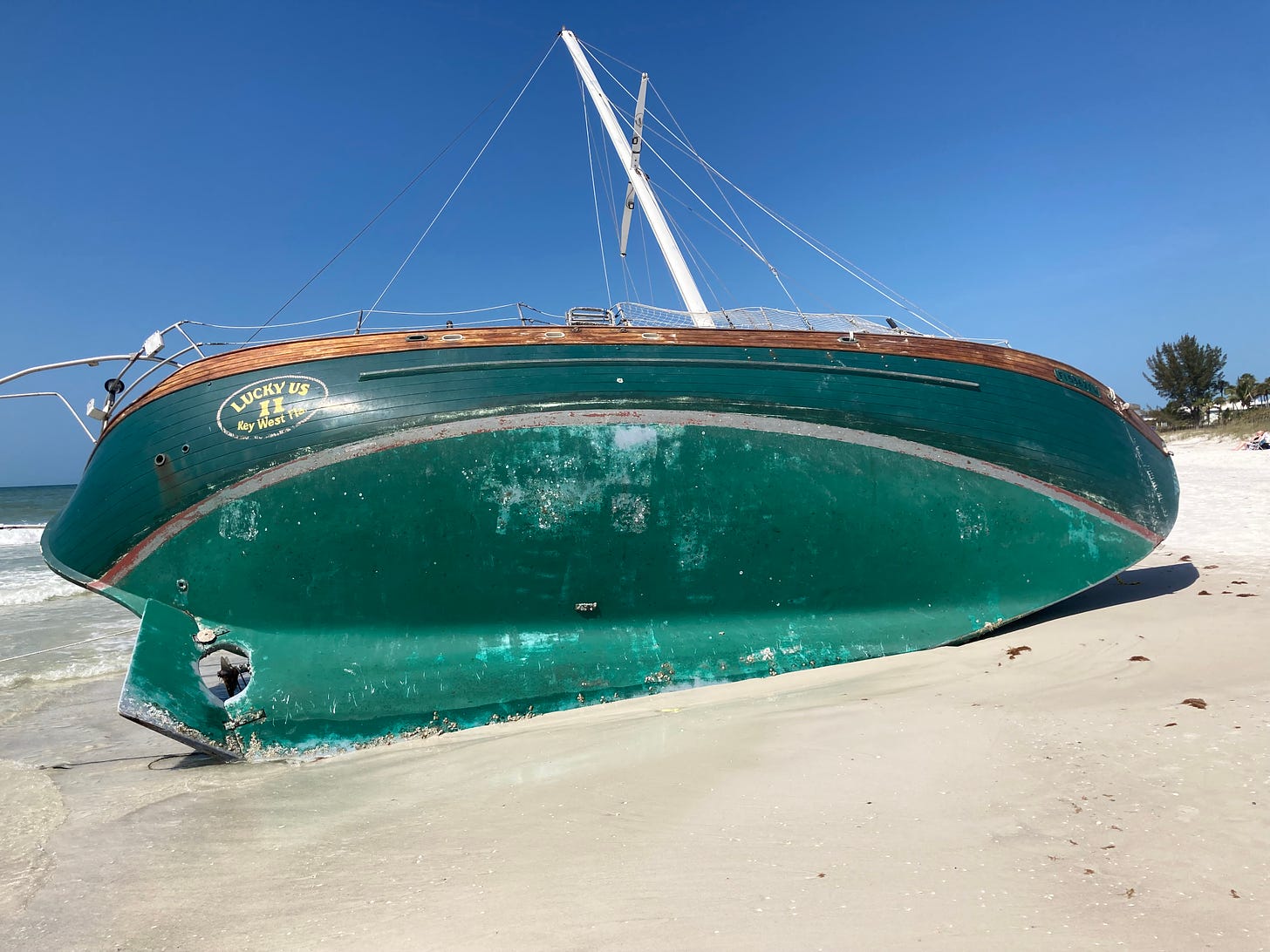
What’s my final take?
The red tide is a naturally-occurring algae that produces a neurotoxin fatal to fish and quite likely damaging to our human brains. While it may have contributed to fish kills over the ages, it has been exacerbated by the high nitrogen and phosphorous pollutants and runoffs from increased industrial, farming, and wastewater/septic runoff in and around the Gulf Coast and throughout the Mississippi River delta. It’s our fault that these long-running red tide blooms have become more dramatic and harmful. Nature, in the form of algae, is merely trying to procreate by killing fish to create even more nutrients to bloom as it off-gasses with airborne neurotoxins. We breathe them in and are affected and afflicted, slowly, perhaps imperceptibly until some smart researcher comes along and shows of proof of increased numbers of people with Parkinson’s or Alzheimer’s or Lou Gherig’s Disease (ALS) who live near red tide blooms.
One such researcher, a neurologist named Dr. Elijah Stommel of the Geisel School of Medicine at Dartmouth, has long been exploring the impact of blue-green algae blooms and the airborne cynaobacteria they produce. These research outcomes, based on large-scale mapping projects using satellite remote-sensing to assess relationships with ALS patients, support the hypothesis that an elevated blue-green algae presence correlates with as much as a 48% increase in ALS risk.
We’ll need to change our lifestyles and eliminate pollutant runoff into the Gulf of Mexico and other water bodies to reverse the red tide trend and the Florida neurotoxin “gas chamber” effect. If we don’t, our uniquely-human Fish-Eye Syndrome will likely persist across future generations, causing fatalities and neurodegenerative disease at increasing rates.
Dave Celone, of Sharon, VT, writes from a Holmes Beach bungalow on Anna Maria Island off Florida’s central-western coast, wondering whether the shellfish he ate last night might have been tainted by red tide toxins. He wonders whether red tide’s algal brevetoxins are similar to the airborne blue-green algae cyanotoxins that have been scientifically studied and reported to be a link to neurodegenerative disease like ALS (Lou Gehrig’s Disease) in humans living on or near lakes and water bodies where algae blooms occur. Further, he wonders whether anyone is studying and correlating the neurological impacts on people living near ponds and lakes with blue-green algae blooms to those afflictions of people living near coastal areas impacted by red tide algae blooms. Finally, he wonders whether Fish-Eye Syndrome will enter the national lexicon and psyche as a recognized affliction causing so many people to turn a blind eye as they suffer in the face of excruciatingly slow and harmful environmental changes across generations. For Dave, this all begs three questions: “What kind of world are we leaving for our children?”, “Am I vacationing in America’s greatest gas chamber?”, and “How much damage have I done to my own brain by walking a sandy beach in Florida where airborne neurotoxins are present?” Without further advances in brain science research on the causes and effects of neurodegenerative disease, it seems, unfortunately, only time will tell.
Dave can be reached by posting a comment below. Subscriptions to this online journal are free.



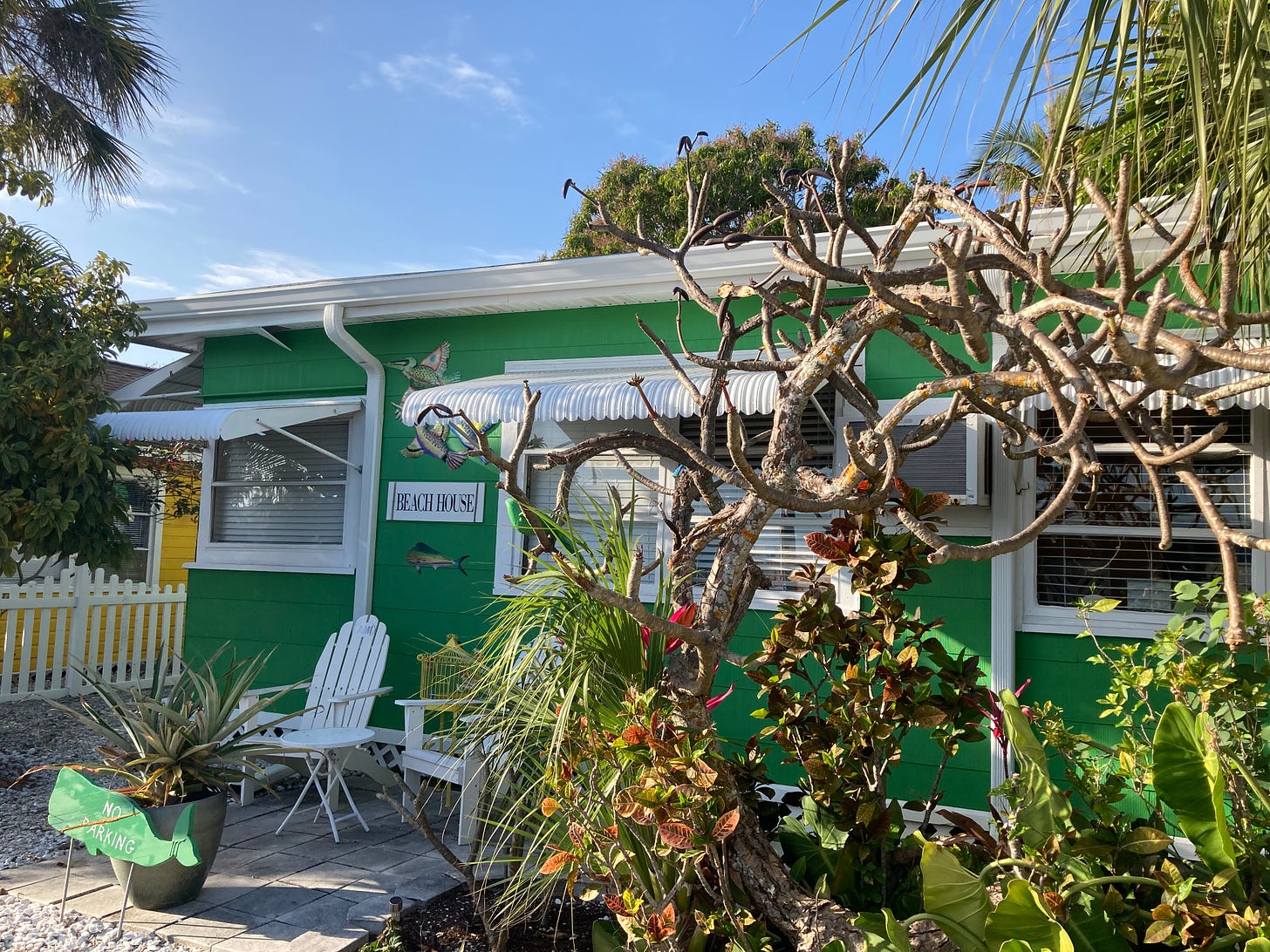
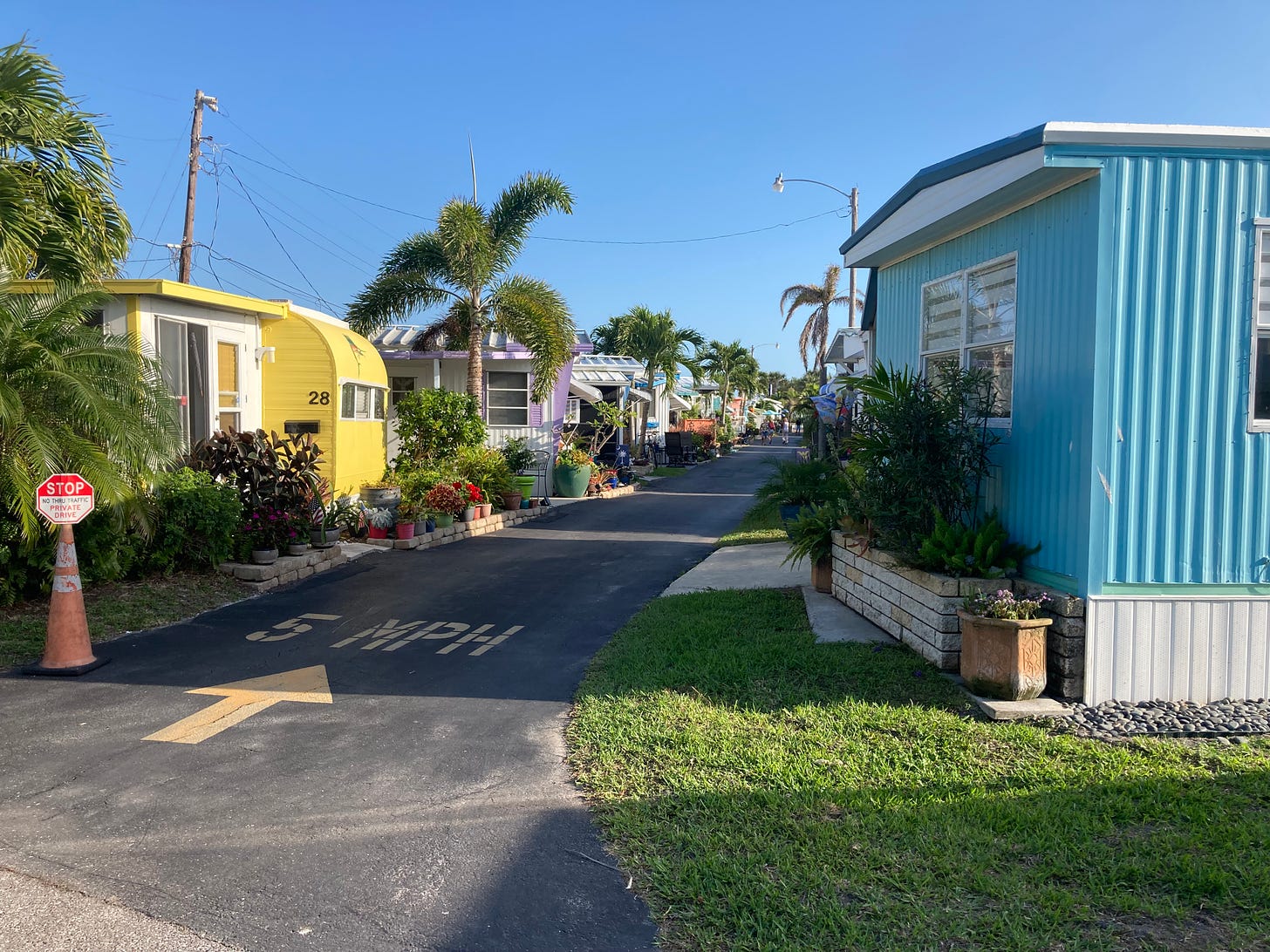
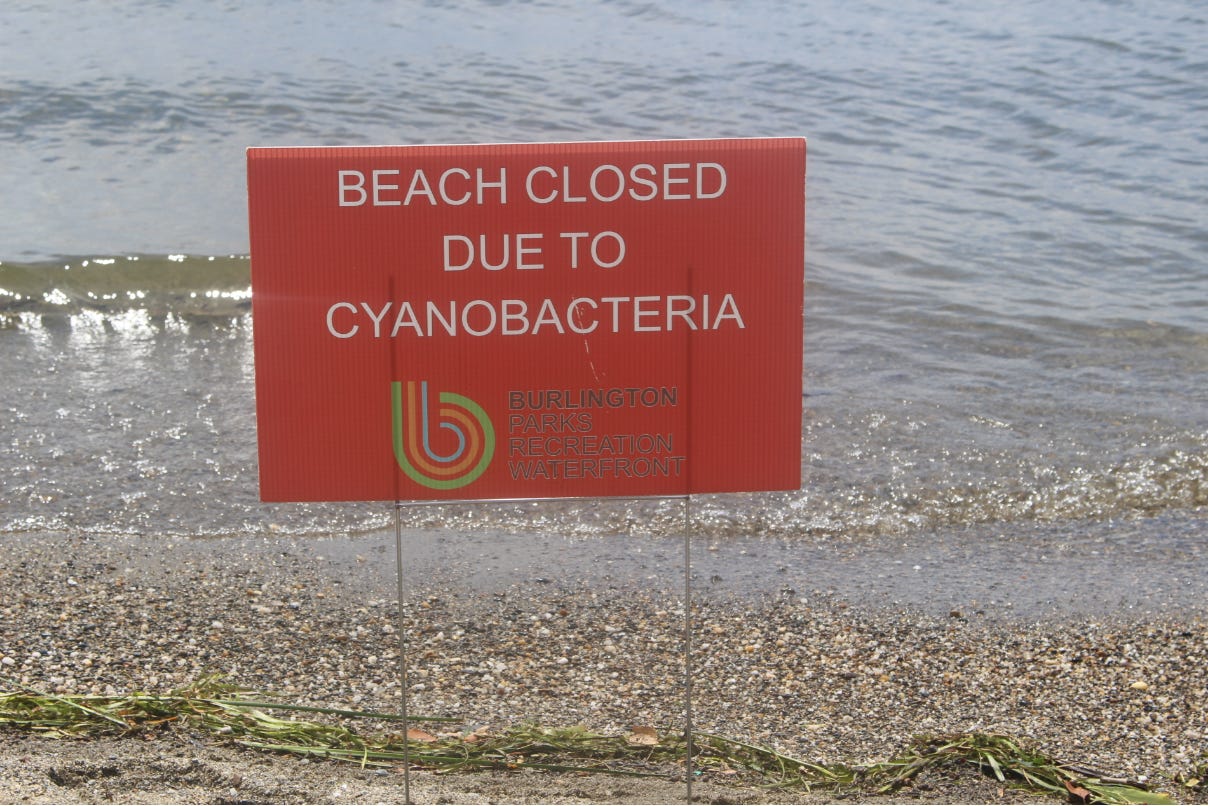
Thank you for reporting on this. It's shocking and so so tragic, but glyphosate runoff from Midwest farms--thank you Monsanto!--has created "cancer alley" over the last decades as it all flows south and concentrates just before hitting the sea. Why people aren't more shocked, and don't insist on organic farms everywhere--the way nature intended!--is a mystery to me. (Oh, maybe because we're supposed to accept this as some kind of modern "normal" we just have to "live with" and there's the fact that this is simply not reported, since our country seems to value corporations and money over people.) This mess is a result of CAFO's and "farming" with poison (well, and add to that oil spills, PFAS, etc.) We're witnessing the death of beautiful nature. We've been hoodwinked as a society to think of disease as "normal" and we've allowed big ag to control our food system with junk food, and big pharma to now control tv, radio, and just about everything with the aim to "fix" the diseases that the junk food causes. What a money-maker, while we kill off people! Thank you for your exposé on human insanity. It's beyond the pale.
My grandma has Lou Gehrig’s disease, she is about 75 years old it was diagnosed 2 years ago. Right now it’s getting more difficult to live for her, because of stiff muscles she can’t even move. Riluzole and Edaravone medicines are given, but won"t give much relief. She can"t eat food without choking. I thought this might be the last stage and the medications she was given did not help at all, so I started to do alot of research on natural treatments, I was introduced to Health Natural Centre and their ALS Herbal Protocol. She started on the ALS/MND Treatment last year, her symptoms gradually diminished including her vocal cord spasm, Body Weakness and Difficulty with swallowing. Reach them at healthnaturalcentre.org , She is getting active again since starting this treatment, she is able to walk again ( down the street and back )she have also resumed exercising to strengthen muscles!! God Bless all ALS Caregivers. Stay Strong, take small moments throughout the day to thank yourself, to love your self, and pray to whatever faith, star, spiritual force you believe in and ask for strength. I can personally vouch for these remedy but you would probably need to decide what works best for you.